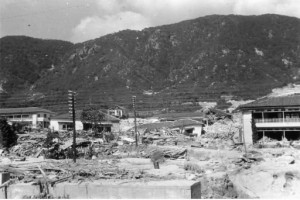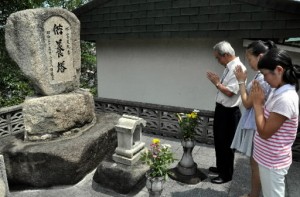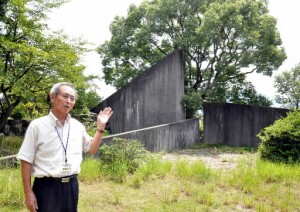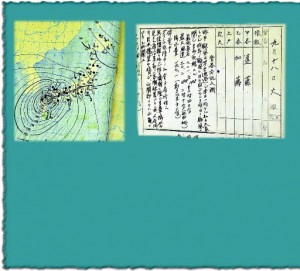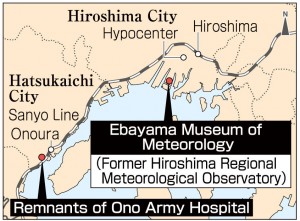Peace Seeds: Teens in Hiroshima Sow Seeds of Peace (Part 16)
Aug. 27, 2015
Part 16: Makurazaki Typhoon hit Japan soon after war ended
On September 17, 1945, about one month after the end of World War II, a huge typhoon, known as the Makurazaki Typhoon, hit the Japanese archipelago. This severe storm produced a number of mudslides in Hiroshima Prefecture, claiming many lives in the city of Hiroshima, so soon after the atomic bombing, as well as in the city of Kure and the village of Ono (now the city of Hatsukaichi), where there is steep terrain. In all, over 2,000 people perished in Hiroshima Prefecture.
This widespread damage was caused by a combination of factors. The destruction wrought by the powerful fury of the typhoon was compounded by the weaker state of Hiroshima following the war. Mother Nature’s rage was a terrible blow to local residents as they sought to rise again after the war and reconstruct their lives.
This year marks the 70th anniversary of the atomic bombing and the end of World World II, as well as the Makurazaki Typhoon. The fact that many lives were lost in this natural disaster, in addition to the atomic bombing of Hiroshima and the air raids that took place on other cities in the Hiroshima area, must not be forgotten.
Typhoon brings further suffering
On September 17, 1945, a total of 2,012 people in Hiroshima Prefecture lost their lives.
The Makurazaki Typhoon struck Hiroshima Prefecture on the night of September 17, 1945 and continued through dawn the next morning. In the city of Hiroshima, the peak instantaneous wind speed was 45.3 meters per second while the maximum wind speed, overall, was 30.2 meters per second. The amount of rainfall reached 218.7 millimeters in those two days, exceeding the total amount of rainfall for the average September.
According to a record of land-related disasters in the history of Hiroshima Prefecture, the death toll from the typhoon rose to 2,012 in the prefecture. Over 80 percent of the victims were killed in landslides. In Kure, 1,154 people lost their lives. Because the population of Kure quickly ballooned as its munitions industry grew during wartime, houses were built at the edge of mountains and frequent air raids on this city weakened the mountain surfaces. In the city of Hiroshima, on the heels of the atomic bombing, 24 people died.
The typhoon tormented the war’s survivors as they sought to rise from the ruins around them. Kogiku Inou, 85, a resident of Aki Ward, Hiroshima, had already experienced the atomic bombing and lost family members, including her mother, in the A-bomb attack. Recalling that time, when she was 15 years old, she said, “I was completely at a loss.”
Her house in the Danbara-shinmachi district (now part of Minami Ward) had already been destroyed in the atomic bombing. And then, because of the typhoon, her clothing and other belongings were ruined by rain and mud. In the aftermath of the typhoon, she headed for her grandmother’s house in the village of Kuba (now part of Higashi-hiroshima City), but trains on the Sanyo Line were not running due to mudslides. She was forced to walk a full day instead. Along the way, she saw railroad tracks hanging over the gushing Senogawa River, as the embankment had been washed away.
Masatomo Endo, 43, a curator at the Ebayama Museum of Meteorology in Naka Ward, pointed out several reasons for such extensive damage: the force of the typhoon was especially strong; buildings still standing after the war were vulnerable; and heavy rainfall accumulated in September. At the same time, an attempt to warn people in Hiroshima of the approaching storm did not adequately reach the public amid the chaotic conditions after the war.
Mr. Endo said, “The damage caused by the Makurazaki Typhoon has not been well understood, as it stands in the shadow of the destruction wrought by the atomic bomb. But I hope that people will also reflect on this disaster, which hit so soon after the war ended.” (Harumi Okada 16)
Makurazaki Typhoon
This powerful storm struck Japan soon after the end of World War II, devastating many parts of the country. The typhoon made landfall near the city of Makurazaki in Kagoshima Prefecture at 2 p.m. on September 17, 1945. The atmospheric pressure recorded in the city was 916.1 hectopascals, only second to the Muroto Typhoon, which lashed Japan before the war. The Makurazaki Typhoon moved northeast, generating great gusts of wind, including a peak instantaneous wind speed of 75.5 meters per second in Miyazaki Prefecture. After wreaking havoc on the Chugoku, Hokuriku, and Tohoku regions, the storm left the Japanese archipelago at Sanriku Coast. Nationwide, the death toll was around 3,700.
Mudslide hits hospital, claims A-bomb survivors
The Ono Army Hospital, located in the village of Ono, was hit directly by a mudslide that came from the mountain behind it. The disaster took the lives of 156 people. Kenji Nishio, 72, a member of the Ono History Association, took us to the site.
At the time of the typhoon, the hospital, which stood on a terraced slope, accommodated about 100 A-bomb survivors who had suffered injuries in the bombing. Also at the hospital was a team of about 40 medical school professors and physicists from Kyoto University who were there to provide medical support for the survivors and study their conditions.
At 10:20 p.m. on September 17, a massive mudslide was carried down by the Maruishi River, which ran through the center of the hospital grounds. The hospital building, where the A-bomb survivors and team members from Kyoto were staying, was quickly destroyed and most of the people inside, including hospital staff, were swept away across the Sanyo Line railroad tracks to the south, and out to sea, along with the wreckage.
Twenty-five years after the disaster, Kyoto University erected a memorial near the site to remember the 11 team members who died that day. We were told that the four triangular-shaped walls rising to the sky represent “the rebirth of human beings.” Around the monument are boulders that tumbled down from the mountain. Some of these rocks measure about two meters in diameter, much taller than me, and I was unable to match their circumference with my arms.
Another memorial, dedicated to all 156 people who perished in the disaster, was raised on the grounds of a nursing home nearby. Mr. Nishio said, “For the sake of those who lost their lives in the typhoon and the atomic bombing, I pray that we all can live safe and peaceful lives.” (Mei Morimoto, 17)
Weather chart shows storm’s fury
We had a chance to look at the weather chart from that time and the daily report written by a staff member on duty that day. These documents are preserved at the Hiroshima Regional Meteorological Observatory. From these aging records, we were able to grasp the terrible fury of the Makurazaki Typhoon.
The weather chart showed that the typhoon enveloped the whole Japanese archipelago. The tightly-drawn isobaric lines meant that the force of the typhoon was staggering. At 6 p.m. on September 17, the eye of the storm was in northern Kyushu; by 6 a.m. on September 18 it had nearly reached the Noto Peninsula in the Hokuriku Region. This indicates that the storm traveled very quickly through the Chugoku Region.
Only three lines were written about the typhoon in the staff member’s daily report on September 17. Then 13 lines were written about the power of the typhoon, and the damage it caused, on September 18. As a staff member of the observatory, this person showed a real sense of duty in monitoring the huge typhoon not long after the atomic bombing. (Chiaki Yamada, 15)
Experiencing wind speed of 20 meters per second
I experienced a wind speed of 20 meters per second at the Ebayama Museum of Meteorology. This wind speed was only two-thirds of the maximum wind speed recorded in the city of Hiroshima at the time of the Makurazaki Typhoon, but even so, I felt the wind’s overwhelming power.
To experience this wind speed, I entered a machine which blows the wind from a huge tube at the front. The wind speed increased from five meters per second to 15 meters per second, then reached the maximum of 20 meters per second. At the maximum wind speed, I was unable to open my eyes or mouth or freely move my body. It was like my body was fixed in place. I heard only the roaring of the wind, no other sound. Yet the wind was only blowing at my upper body. If it had been hitting my whole body, I don’t think I could have stayed on my feet.
In fact, during the actual typhoon, people on the muddy ground were hit much harder by the wind, as there was driving rain, too. The war had already damaged their homes, and they were unable to take steps to prepare for a typhoon. In the overwhelming wind and rain, the people must have been terrified and had to endure more suffering. (Hisashi Iwata, 14)
Junior writers’ impressions
I didn’t know any of the details of the Makurazaki Typhoon. But in the process of gathering materials for this article, I came to realize how huge the damage in Hiroshima was. I think we should pass on this information about the typhoon, which took a lot of lives, too, like the atomic bombing, to the next generation. (Harumi Okada)
After my personal experience of powerful wind and rain, and the chance to read the daily reports and other materials from that time, I was able to imagine, with my senses, how devastating the typhoon was. Learning through experience can make it easier for us to imagine the minds of other people. I think this is a really effective way to hand down memories. (Shiori Niitani)
The site where the hospital was has steep mountain slopes and long, sloping roads. The topography of the place feels similar to the Yagi district in Asaminami Ward, which suffered terrible mudslides last year. The huge rocks that rolled down the mountainside show the frightening power of natural disasters, and made me want to tell the story of the disaster there to as many people as possible. I want others to know about the Makurazaki Typhoon, which also killed a lot of people in Hiroshima. (Mei Morimoto)
At the Ebayama Museum of Meteorology, I was also able to see the weather chart from 6 a.m. on August 6, 1945, the day the atomic bomb was dropped on Hiroshima. The chart showed that Hiroshima was covered by high pressure, which meant it was a fine day. I felt choked up when I imagined that about two hours later the airplane called Enola Gay would drop the atomic bomb, bringing tragedy to the city. (Chiaki Yamada)
I learned how powerful the Makurazaki Typhoon was and how much the people of Hiroshima suffered as a result. Also, I was able to hear a lot about weather and typhoons, which I already knew something about. (Hisashi Iwata)
At the Ebayama Museum of Meteorology, located about 3.7 kilometers from the hypocenter of the atomic bomb, there are still fragments of glass stuck in the wall. I had visited the museum a number of times before, but I hadn’t noticed them. In this assignment, though, I felt the power of the atomic bomb, and I was amazed at the sense of responsibility assumed by the people at the observatory, who kept monitoring the weather conditions even in the difficult circumstances after the bombing. (Yoshiko Hirata)
I was really struck by the memorial to the victims from Kyoto University and the big rocks around it, which had rolled down from the mountain. When I took photos of the monument, I had to stand far away to get everything in the frame. I tried touching the top of a boulder, but I couldn’t reach that high, even when I stretched. The boulders tumbling down from the mountain, one after another, show how the mudslide couldn’t have been prevented. (Kotoori Kawagishi)
What is Peace Seeds?
Peace Seeds are the seeds of smiles which can be spread around the world by thinking about peace and the preciousness of life from various viewpoints. To fill this world with flowering smiles, 49 junior writers, from the sixth grade of elementary school to the last year of high school, choose themes, gather information, and write articles.
(Originally published on August 27, 2015)

